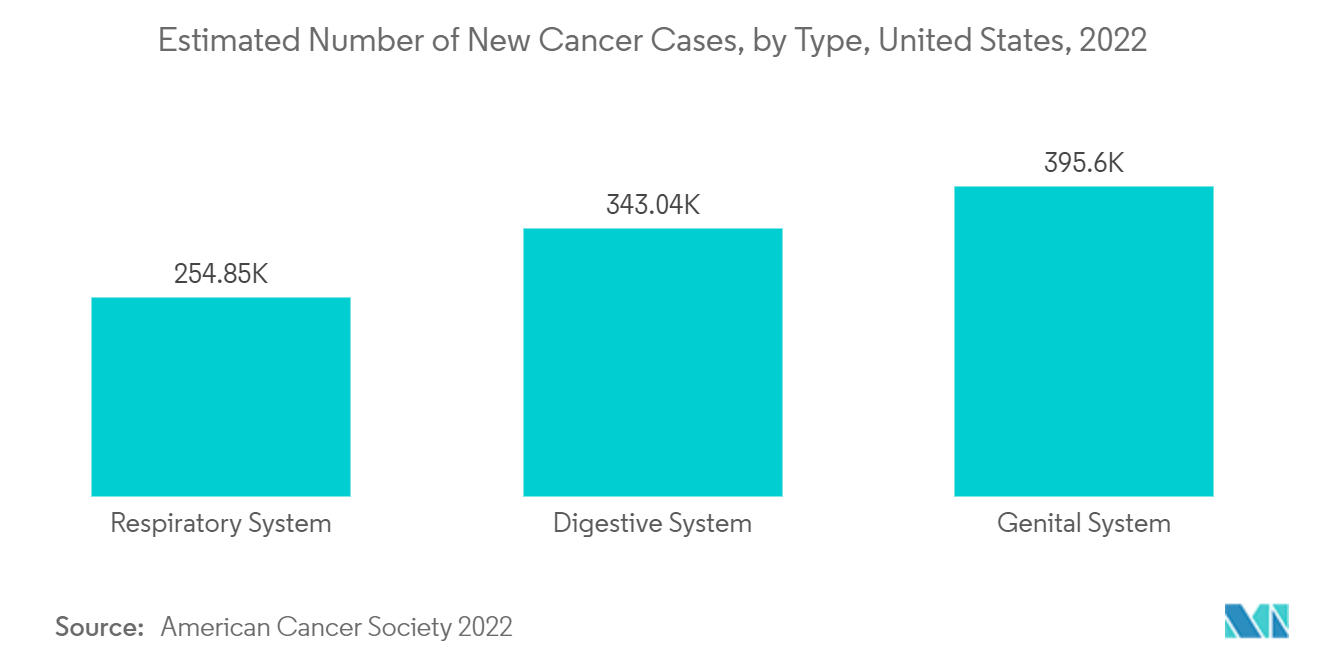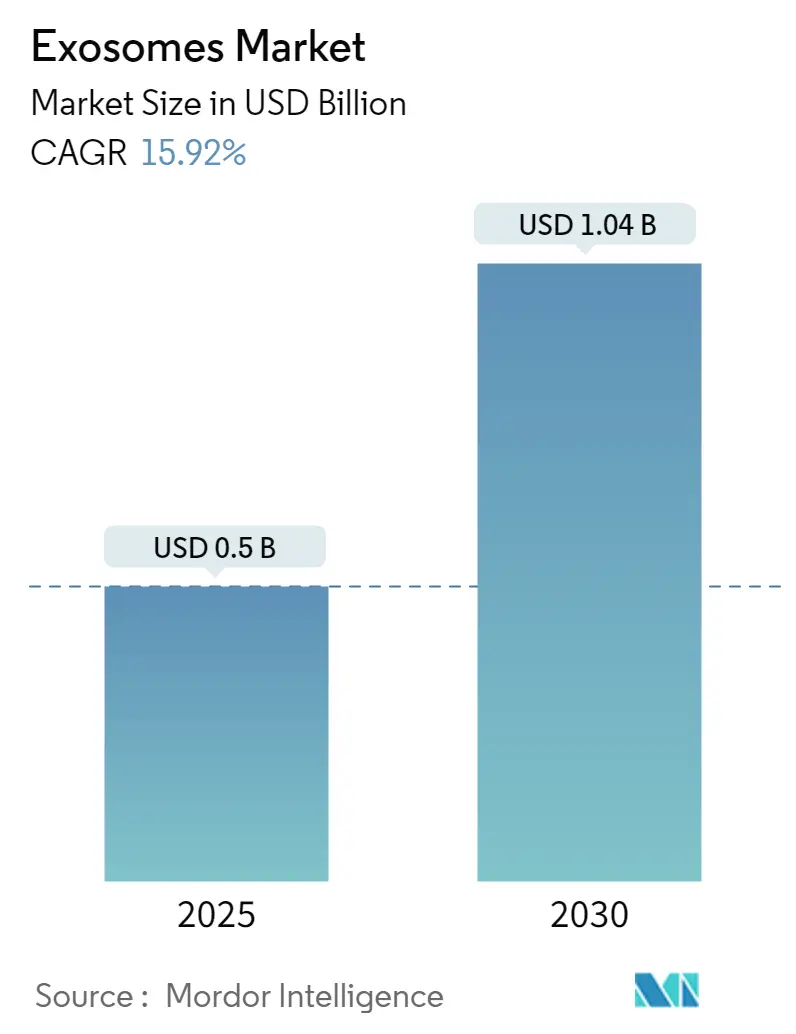
| Study Period | 2019 - 2030 |
| Market Size (2025) | USD 0.5 Billion |
| Market Size (2030) | USD 1.04 Billion |
| CAGR (2025 - 2030) | 15.92 % |
| Fastest Growing Market | Asia Pacific |
| Largest Market | North America |
| Market Concentration | Medium |
Major Players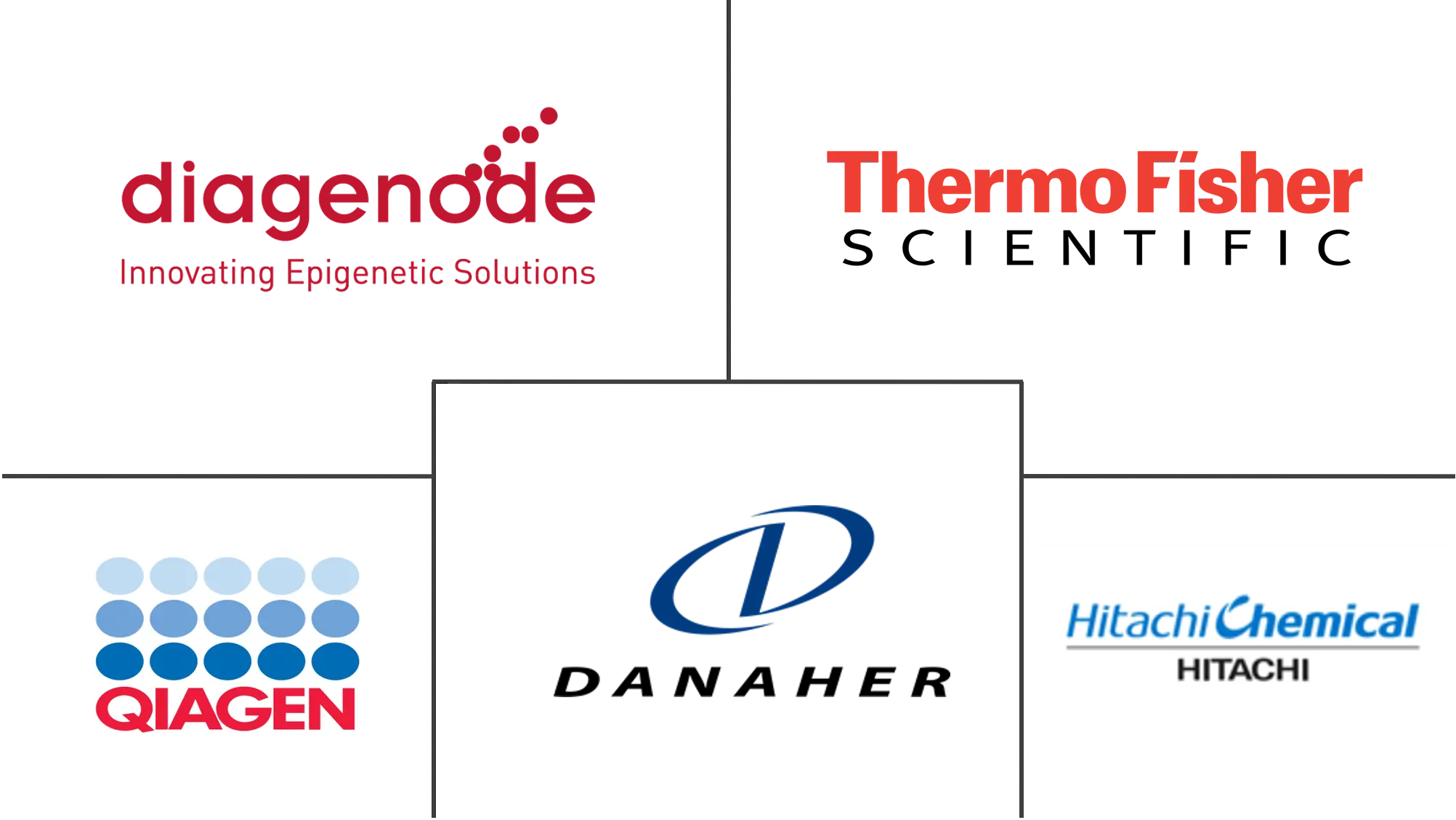
*Disclaimer: Major Players sorted in no particular order |
Exosomes Industry Analysis
The Exosomes Market size is estimated at USD 0.50 billion in 2025, and is expected to reach USD 1.04 billion by 2030, at a CAGR of 15.92% during the forecast period (2025-2030).
Certain factors that are driving market growth include the increasing prevalence of cancer, technological advancements in Exosome isolation and analytical procedures, and increasing advanced applications of exosomes. The growing prevalence of cancer patients directly impacts the increased demand for exosomes. According to the GLOBOCAN 2020 report, 19.29 million people are living with cancer, and this number is expected to rise over the next two decades across the globe. With the rising number of cancer cases, it is expected that the application of exosomes in coping with cancer would be high, which is expected to contribute to the market growth.
Exosomes extracted from cow's milk are used in Exosome drug delivery of therapeutic molecules against lung and breast cancer. Exosomes derived from specific sites of the body are promising candidates for anti-cancer vaccines due to their enhanced passive targeting and their small Exosome size, indigenous nature, and ability to cross biological barriers. Thus, the increase in the number of cancer cases in hospitals directly increases the demand for exosomes in diagnosis as well as therapeutics.
However, many technical difficulties need to be addressed to successfully implement Exosome technology in various applications. This is one of the primary hindrances to the growth of the exosomes Industry. Some of the major difficulties include optimization of purification, increasing the homogeneity of exosomes, and efficient transfection strategies. This is further accompanied by a lack of technical information (like the type of rotor, diameter, volume, and viscosity of the sample), which restricts the maximum utilization of exosomes.
The cumbersome nature of the methods for isolation and purification and the inability to distinguish between different cancer stages with an incomplete understanding of the immune system may limit the global market. Moreover, other factors limiting the growth of this market are the stringent regulatory requirements for the approval and commercialization of exosome products.
During the COVID-19 pandemic, there was a rising demand for exosomes. Exosomes, with a size of exosomes ranging from 30-120 nm, are extracellular vesicles that participate in several pathological conditions. Virus-infected cells release exosomes that are implicated in infection by transferring viral components such as viral-derived miRNAs and proteins. Exosomes also contain receptors for viruses that make recipient cells susceptible to virus entry. The spike protein cleavage by transmembrane protease serine 2 (TMPRSS2) is needed for COVID-19 virus entry and infection via interaction with the angiotensin-converting enzyme 2 (ACE2) receptor. There is evidence that exosomes transfer ACE2 to recipient cells, suggesting a supportive function for COVID-19 virus internalization and infection. A study published by the National Institute of Health in January 2022 suggests that the COVID-19 infection has a direct connection with exosomes in terms of the emergence of the virus inside the body and its spread. Additionally, it is observed that circulating exosomes carrying lung-associated self-antigens, viral antigens, and the 20S proteasome are more prevalent in individuals with coronavirus infection. Hence, with the above-mentioned factors, it is noticeable that the COVID-19 pandemic had a significant impact on the global market. However, post-pandemic, Exosome research has evolved with its widening applications.
Exosomes Market Trends
The Therapeutic Application Segment is Expected to Hold the Largest Market Share
Exosomes have promising potential to be a vehicle for Exosome drug delivery as they have natural material transportation properties, the capability to support intrinsic long-term circulation, and high biocompatibility, which are the most suitable factors for the delivery of a variety of proteins, chemicals, and nucleic acids. According to a few research studies, exosomes have generated positive results as mediators of intercellular communication, potentially delivering functional proteins, mRNA transcripts, and miRNAs to cells throughout the body, thereby contributing to advancements in Regenerative medicine.
Exosomes, derived from some types of cells (such as dendritic and mesenchymal stem cells), have potential therapeutic properties and are biocompatible and efficient agents against various disorders, such as organ injury and various disorders including heart, kidney, liver, and lung illnesses, thus playing a significant role in the Cell therapy market.
Exosomes have the potential to be used as a therapeutic platform for a variety of diseases, including COVID-19, thereby boosting the Exosome therapeutics market. Exosomes have clinical applications as cell-free alternatives for treating various diseases and tissue regeneration by delivering therapeutic cargo components while avoiding immune rejection and cellular toxicity. In addition, stem cell-derived exosomes are advantageous in harnessing the anti-inflammatory and regenerative abilities of parent cells; thus, exosomal treatment can be engineered for respiratory viral diseases, including SARS-CoV-2.
Although there has been rapid progress in the research of exosome applications, there are many challenges in the development of exosome-based therapeutics, particularly in the production of exosome formulations due to their low productivity and heterogeneity. Moreover, there are a few barriers in the storage, optimization, and Exosome isolation methods of exosome formulations.
North America Dominates the Market and is Expected to do the Same in the Forecast Period
During the COVID-19 pandemic, the United States was the most affected country in the world. As exosomes and extracellular vesicles are considered potential mediators of infection, reinfection, and reactivation, the growing number of studies concerning exosomes is positively impacting the U.S. Exosomes market.
The North American region holds one of the largest shares in the global market, owing to better healthcare infrastructure, effective government policies, a huge base of multinational Exosome companies, and high awareness among people about diagnostics and healthcare. Many government-funded research studies have been conducted regarding the role of drugs using exosomes in several kinds of cancer, such as melanoma, breast cancer, lung cancer, and pancreatic cancer, among others. Companies like Merck and Exosome Diagnostic, leading Exosome companies, have sponsored and collaborated with several universities, such as Yale University and Michigan State University, to conduct clinical trials in the United States. Furthermore, these ventures are very well supported by government funding. The studies were mostly conducted for neoplasms.
New technologies are fueling market growth. For instance, according to the Lab on Chip Journal publication of July 2022, the United States is experiencing wide adoption of emerging micro-nanotechnologies for extracellular vesicles in immuno-oncology ranging from target-specific isolations to immunomodulation. With the adoption of new technologies, the market studied is expected to witness strong growth in the coming years.
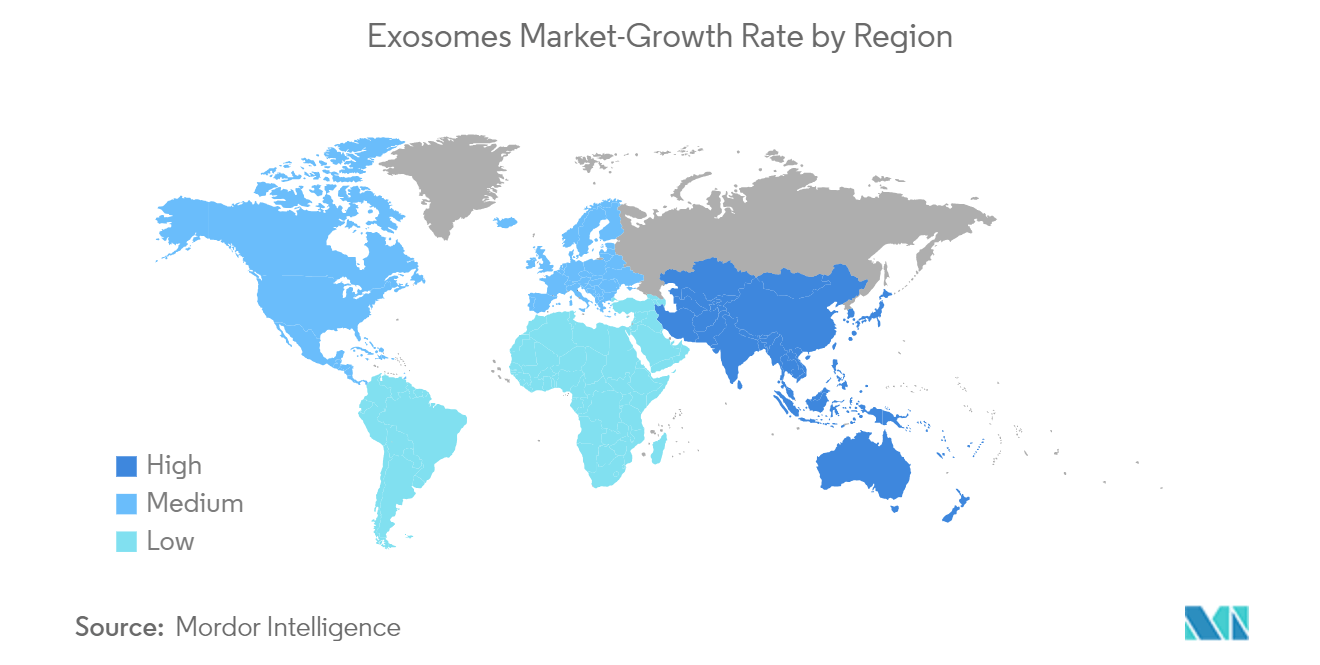
Exosome Industry Overview
The exosome sector is highly competitive and consists of a number of major players. Companies like Danaher (Beckman Coulter Inc.), Diagenode Inc., Fujifilm Holdings Corporation, Hitachi Chemical Diagnostics Inc., Lonza, MBL International, Miltenyi Biotec, Novus Biologicals, Qiagen, and Thermo Fisher Scientific Inc., among others, are leading Exosome companies holding substantial market share in this field.
Exosomes Market Leaders
-
Diagenode Inc.
-
Hitachi Chemical Diagnostics Inc.
-
Qiagen
-
Thermo Fisher Scientific Inc.
-
Danaher (Beckman Coulter Inc.)
- *Disclaimer: Major Players sorted in no particular order
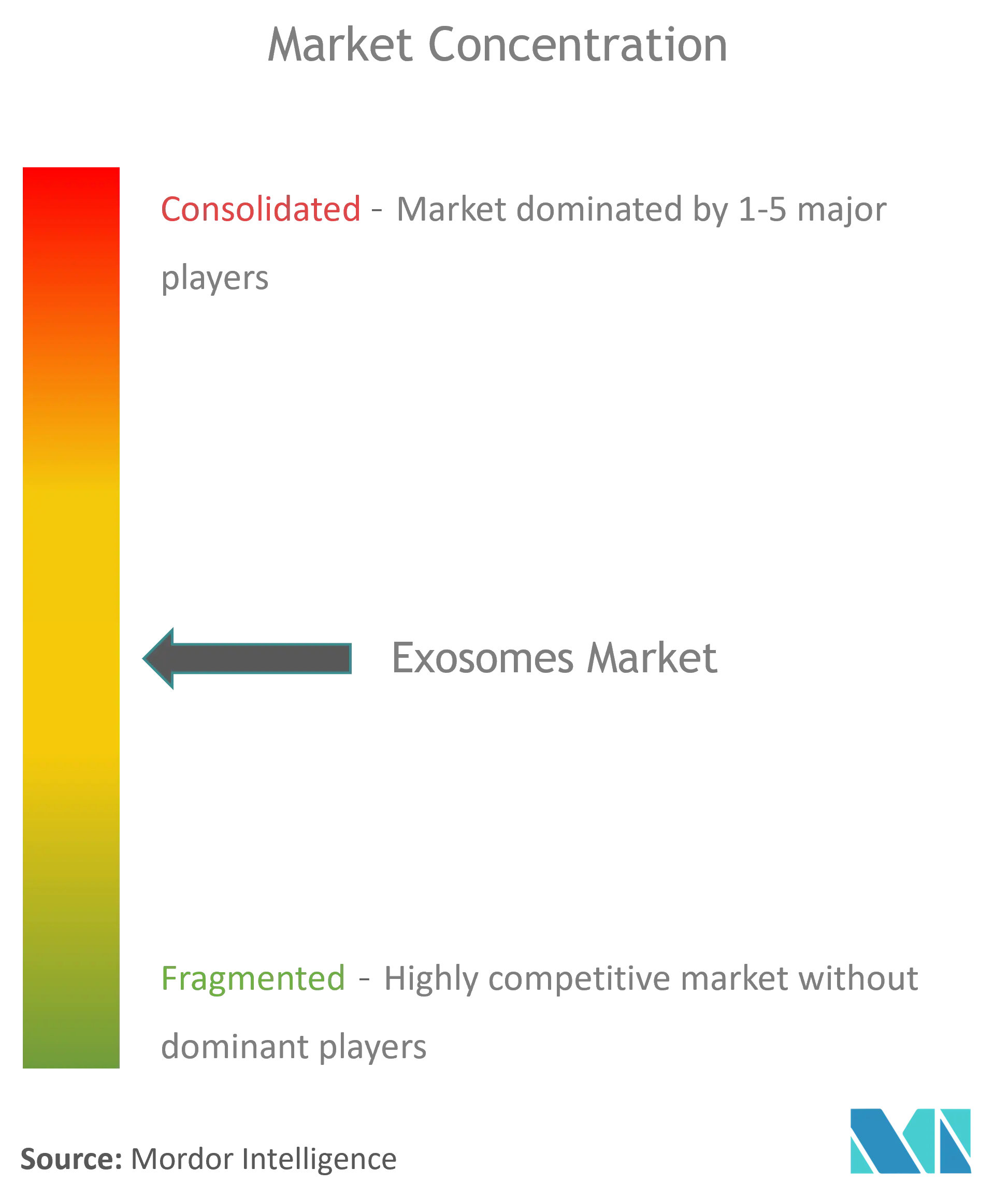
Exosomes Market News
- October 2024: Abcam, now a subsidiary of Danaher Corporation, unveiled a new range of exosome-specific antibodies and kits to support advanced exosome research, focusing on improving detection and characterization methodologies.
- September 2024: Bio-Techne announced the development of a novel exosome-based diagnostic platform aimed at enhancing biomarker discovery and development across multiple disease areas, including oncology and neurodegenerative disorders.
- August 2024: Qiagen expanded its exosome product line by releasing the "miRCURY Exosome Kits," which utilize precipitation methods to efficiently isolate exosomes from various biofluids, facilitating downstream molecular analyses.
- July 2024: Fujifilm Wako Chemicals U.S.A. Corporation launched the "MagCapture™ Exosome Isolation Kit PS Ver.2," an enhanced version aimed at improving the purity and yield of exosome isolation for research applications.
- June 2024: Thermo Fisher introduced the "Exosome Isolation and Analysis Suite," a comprehensive toolkit designed to streamline exosome research by integrating isolation, characterization, and analysis processes.
Exosome Industry Segmentation
As per the scope of this report, exosomes are small membrane vesicles of endocytic origin that are secreted by most cells in culture and are created upon the fusion of the multivesicular body (MVB), an intermediate endocytic compartment, with the plasma membrane. The global market is segmented by product (kits and reagents, instruments, and other products), by application (diagnostics and therapeutics), and by geography (North America, Europe, Asia-Pacific, Middle East and Africa, and South America). The market report also covers the estimated market size and trends for 17 different countries across major regions globally. The report offers the value (in USD million) for the above segments.
| By Product | Kits and Reagents | ||
| Instruments | |||
| Other Products | |||
| By Application | Diagnostics | ||
| Therapeutics | |||
| Geography | North America | United States | |
| Canada | |||
| Mexico | |||
| Europe | Germany | ||
| United Kingdom | |||
| France | |||
| Italy | |||
| Spain | |||
| Rest of Europe | |||
| Asia-Pacific | China | ||
| Japan | |||
| India | |||
| Australia | |||
| South Korea | |||
| Rest of Asia-Pacific | |||
| Middle East and Africa | GCC | ||
| South Africa | |||
| Rest of Middle East and Africa | |||
| South America | Brazil | ||
| Argentina | |||
| Rest of South America | |||
Exosome Market Research FAQs
How big is the Exosomes Market?
The Exosomes Market size is expected to reach USD 0.50 billion in 2025 and grow at a CAGR of 15.92% to reach USD 1.04 billion by 2030.
What are the challenges of exosome research?
Exosome research faces challenges like difficulty in completely separating macrovesicles from exosomes during isolation, lack of universal and specific markers, and false positives in nanoparticle tracking. There's also complexity in standardizing production methods and quantification techniques and obtaining pure exosomes in sufficient quantities is challenging due to their heterogeneity.
What are the current trends driving growth in the exosomes market?
Trends driving growth in the exosomes sector include increasing prevalence of chronic diseases, advancements in isolation and analytical procedures, government initiatives, and interest in their diagnostic and therapeutic applications.
What are the technological advancements shaping the exosomes industry?
Technological advancements shaping the industry include new isolation techniques like immunoaffinity capture and microfluidic systems, improved characterization methods, exosome engineering for drug delivery, the development of diagnostic tools, and large-scale production of clinical-grade exosomes.
What are the regulatory considerations impacting the exosomes Industry?
Regulatory considerations include stringent approval processes, extensive clinical trials, quality control and safety concerns, FDA regulations, lack of specific frameworks in many countries, and the need for process standardization.
Our Best Selling Reports
Exosome Market Report
The Global Market is segmented by product, application, and geography. The exosomes market is demonstrating significant growth, influenced by the increasing prevalence of cancer and advancements in exosome isolation technologies. These tiny extracellular vesicles play a key role in cell communication and are increasingly used as cancer biomarkers for early disease detection and diagnosis. This has positioned exosomes as a key component in the realm of diagnostic and therapeutic solutions, especially in oncology, propelling the demand for precise and personalized medicine. The market is segmented into diagnostics and therapeutics, with diagnostics gaining traction due to the utility of exosomes in cancer detection. The market size is expanding, particularly in North America, attributed to its advanced healthcare infrastructure and robust research activities. Exosome companies are increasingly focusing on developing kits & reagents, instruments, and services, with kits & reagents taking a dominant share due to their critical role in exosome research. This dynamic growth across various market segments highlights the integral role of exosomes in advancing medical research and therapeutic applications, emphasizing their potential in reshaping healthcare innovations. For further details and market forecast insights, a comprehensive report by Mordor Intelligence™ offers an in-depth market analysis available for free download. The market research reveals that the market size is growing, and the market growth is promising. According to the market report, the exosomes market share is significant in the global market. The industry analysis provides an industry overview, and the industry report includes a thorough market analysis and market forecast. Market leaders are driving market trends, and the growth rate is evident in the industry information. The industry outlook is positive with comprehensive industry reports. The industry research highlights industry sales, industry size, and industry statistics. Market data supports market predictions, and the market review shows detailed market segmentation and market value. This report example is available as a report pdf, and research companies are continually contributing to the market outlook.



